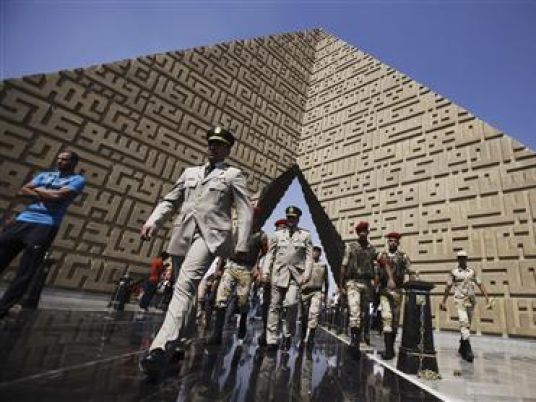Nahdet Misr Street, which runs through the heart of Giza, comprises two of the most prominent landmarks: Nahdet Misr Statue and Cairo University. Both represent an important phase in the history of modern Egypt regarding art and education. The name Nahdet Misr means Egypt's renaisance.
The street is named after the famous Nahdet Misr statue sculpted by Mahmoud Mokhtar, a pioneer of modern Egypt art.
It shows a peasant women standing beside the Sphinx. The statue is an embodiment of Mokhtar’s works, a mixture of ancient Egyptian figures and the contemporary art movement.
The granite statue, which was initially inaugurated in Ramses Square in 1928, now stands opposite to Cairo University Bridge and marks the beginning of Nahdet Misr Street.
Walking forward, leaving the statue behind, the tree-lined street is surrounded by the fence of Giza Zoo and Orman botanical garden. Both were built on the order of Khedive Ismail.
Giza Zoo, the second oldest zoo in the world, was originally inaugurated as botanical garden in 1981. Besides comprising various species of animals and birds nowadays, the zoo is also an institute for studying animal behavior. Though it suffers from negligence, the zoo is considered a “breath of fresh air” to low-income families especially on weekends and feast days.
On the other side of the street lies the Orman garden, which used to be one of the Khedive’s private properties before the state put its hands on it. The name “Orman,” which means forest, is of Turkish origin.
At the intersection of Nahdet Misr Street and al-Gamaa (The University) Street lies the enormous edifice of Cairo University.
It was officially inaugurated on 21 December 1908 in an effort to establish a beacon of enlightenment and a bridge to international scientific advancement at a time education was limited to the study of religion at Al-Azhar University.
When it was established, the university faced financial difficulties along with strong opposition from the British, who occupied the country at the time. As an institute of higher learning, the university played a large part in promoting political awareness, which eventually led to resistance against colonization.
However, national leaders and social thinkers, including Qasim Amin, Mostafa Kamil, and Saad Zaghloul overcame the obstacles and brought the university into being. It was funded mainly by royalties’ donations.
Princess Fatima Ismail was the university’s most generous benefactor. Ismail, King Fuad’s sister, donated jewels worth LE18 thousand along with 600 feddans, in addition to six feddans near her palace.
Cairo University’s dome, which reaches 52 meters in height and is covered with rich ornaments, is one of Egypt’s most prominent landmarks.
The hallowed dome, however, became famous internationally after American President Barack Obama delivered a speech to the Muslim world in the Dome Hall, Cairo University’s main campus, in 2009.
Despite the government’s tight budget for education, LE 50,000 was allocated to polish up the dome in preparation for Obama’s visit.
Cairo University has always been one of the sparks behind Egypt’s most crucial stances against occupation and suppression. In February 1946, thousands of students set off on a march from the university to the Royal Palace against the British occupation. The march ended with what is called the Abbas Bridge Massacre as a result of the brutal attack of the British Army on the marches and an opening up of the bridge under the students’ feet.
In 1971, massive demonstrations were staged by students urging the late Egyptian President Anwar al-Sadat to wage war against Israel to take back the Sinai peninsula.
US withdrawal from Iraq and the al-Aqsa Intifada were the most recent reasons Cairo University students staged protests over the last 10 years.
Finally, stay out of Nahdet Misr Street during rush hour, which lasts considerably longer there than in Cairo’s other streets. The street is always packed with vehicles from 8 am till 6 pm during which time the university opens its doors to students from across the country.




